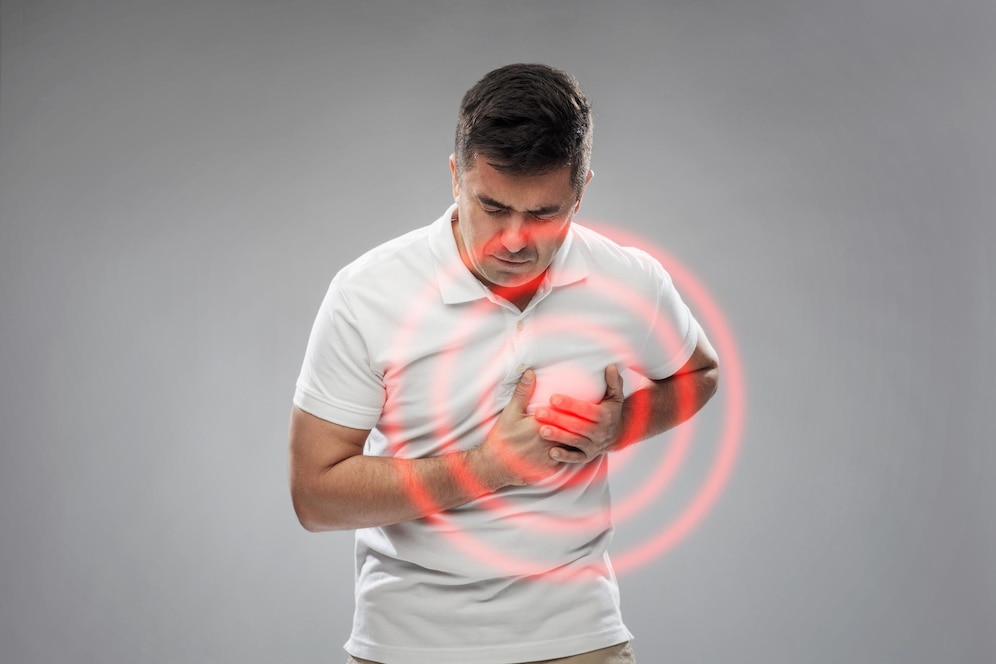Last updated on July 3rd, 2025 at 06:12 pm

Heart attacks (myocardial infarction) happen when a part of the heart muscle does not receive enough blood flow due to a blocked artery. This damages or destroys that part of the heart. Early intervention is crucial in the event of a heart attack. Hence, it’s critical to understand and recognize the symptoms of a heart attack.
Causes of a heart attack
A blockage in one or more of the heart’s arteries typically causes a heart attack. This blockage is caused by plaque (atherosclerosis), a sticky substance that can accumulate on the insides of your arteries. Plaque can rupture, form clots and get lodged within the artery. This restricts blood and oxygen supply to the heart muscle, resulting in a heart attack. If blood flow is not rapidly restored, a heart attack can result in permanent heart damage and death.
Another cause of heart attack is spasms (sudden muscle contractions) of the coronary artery.
Risk factors
The following are some of the most common risk factors for a heart attack:
• Increased low-density lipoprotein (LDL) cholesterol
• Diabetes
• Unhealthy lifestyle
• Smoking
• Obesity
• High blood pressure
• Family history of heart attack
• Age above 45 years (high risk)
Symptoms of a heart attack
Symptoms may vary from person to person. For some, it may be mild symptoms, and for others, severe. Some people might have no symptoms of a heart attack at all.
Here are some common symptoms:
• Chest pain (Angina)/discomfort: Pain/discomfort that lasts over a few minutes in the centre or left side of the chest. It may feel like squeezing, pressure, gripping pain, tightness/heaviness/fullness.
• Pain may extend to the lower jaw, neck, throat, arm and/or neck.
• Feeling faint and nauseous
• Sweating
• Increased heartbeat
• Nausea, vomiting
• Anxiety
• Difficulty in breathing
• Indigestion
Men and women can experience different symptoms of a heart attack. Chest pain may not be the most typical symptom in women. Other symptoms of a heart attack, like shortness of breath, nausea, vomiting, and back or jaw pain, may predominate.
Prevention
Never hesitate to call for emergency help if you are experiencing symptoms of a heart attack.
You can lower the chances of having a heart attack by:
• Quitting smoking
• Managing your weight
• Following a healthy lifestyle
• Regularly exercising: 2.5 hours of moderate-intensity exercise per week for adults and one hour of physical activity per day for children and adolescents.
• Reducing foods high in trans fats, such as fried foods, cakes, cookies, etc.
• Consuming foods rich in fibre, like whole grains, fruits and vegetables.
• Limiting alcohol consumption
• Reducing salt
• Controlling sugar intake
• Following the healthcare advisor’s guidelines
• Taking medicines and following lifestyle modifications
• Monitoring cholesterol, blood pressure and blood sugar.
Treatment
A heart attack is a medical emergency that requires quick attention. Thanks to modern treatment, many people today survive heart attacks. Oxygen is administered right away. Treatment includes medications and/or surgical intervention depending on the extent of the block.
Medications that are usually administered include:
• Anti-clotting medications: Aspirin, anti-platelet agents/blood thinners, heparin, thrombolytics, pain killers, morphine, and nitroglycerine, which increase blood artery width to facilitate easy blood flow
• Blood pressure-reducing medicines: Beta-blockers, ACE inhibitors, and statins to lower cholesterol.
Surgery or other interventions may be performed to open blocked arteries.
• Coronary angioplasty and stent
• Coronary artery bypass surgery
In some cases, heart attacks can lead to complications such as heart failure, which may require long-term management. Evion LC Tablet and Prestel 40mg Tablet, containing Vitamin E and L-carnitine, is often prescribed to help treat heart failure by reducing oxidative stress and improving energy metabolism in heart muscles. Always consult your cardiologist before starting any new medication or supplement.
Create a preventive strategy that is effective for you. You can minimize the risk of heart attack by leading a healthy lifestyle, which will also assist in maintaining normal blood pressure, cholesterol, and blood sugar levels.
FAQs
1. How can I get well after having a heart attack?
Since every heart attack case is unique, your care team will create a thorough treatment strategy. Adapt a healthy lifestyle, and you could be back on your feet in two weeks to three months.
2. What types of tests are used in heart attack diagnosis?
Depending on the symptoms of a heart attack, blood tests and tests like ECG, ECHO, chest x-ray, angiogram, cardiac CT, or MRI may be advised.
3. If I’ve already had a heart attack, am I more likely to have another one?
Yes. You will need to take action to help lower your chance of experiencing another heart attack if the blockage in one or more of your coronary arteries has progressed to the point where it results in a heart attack.